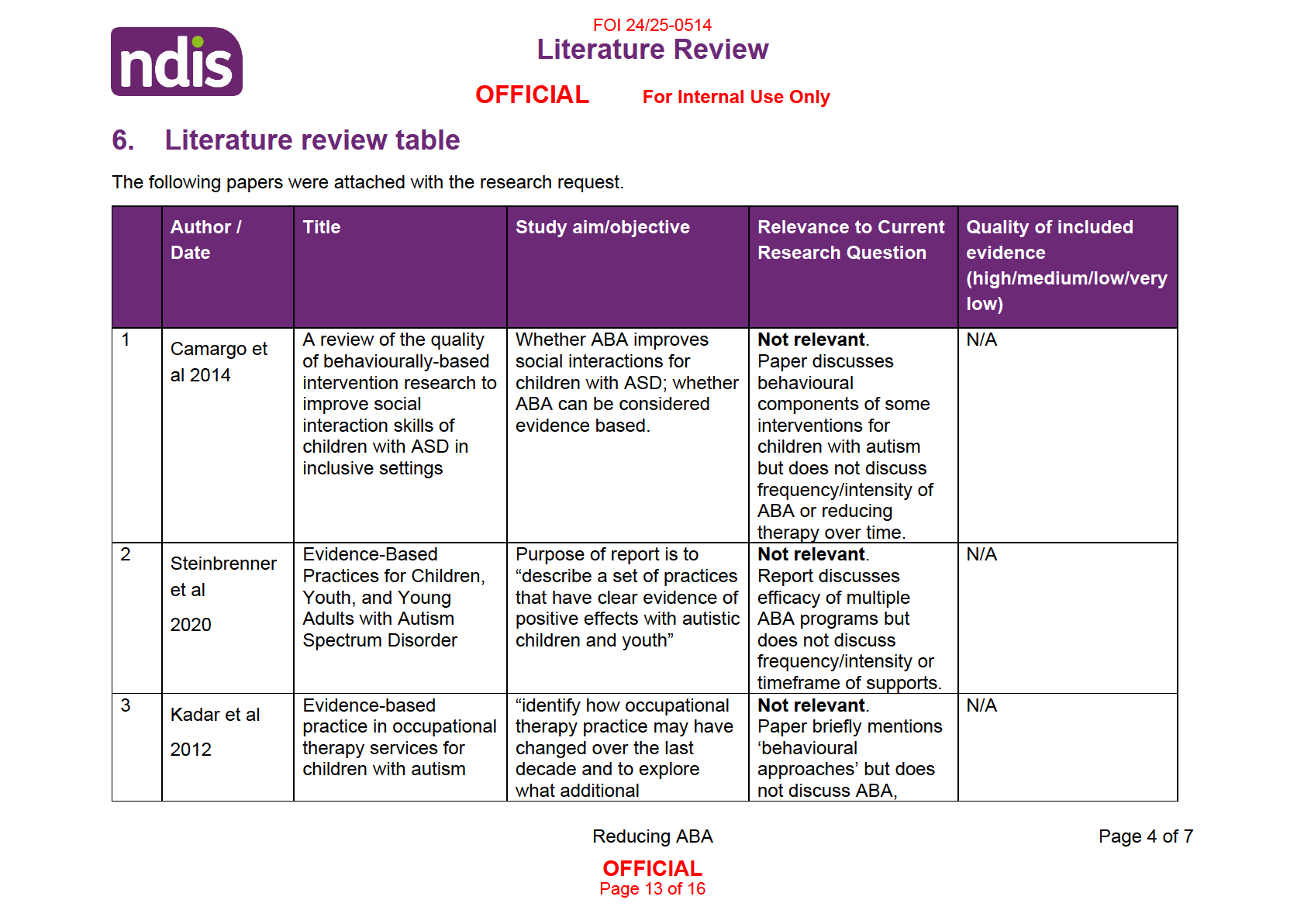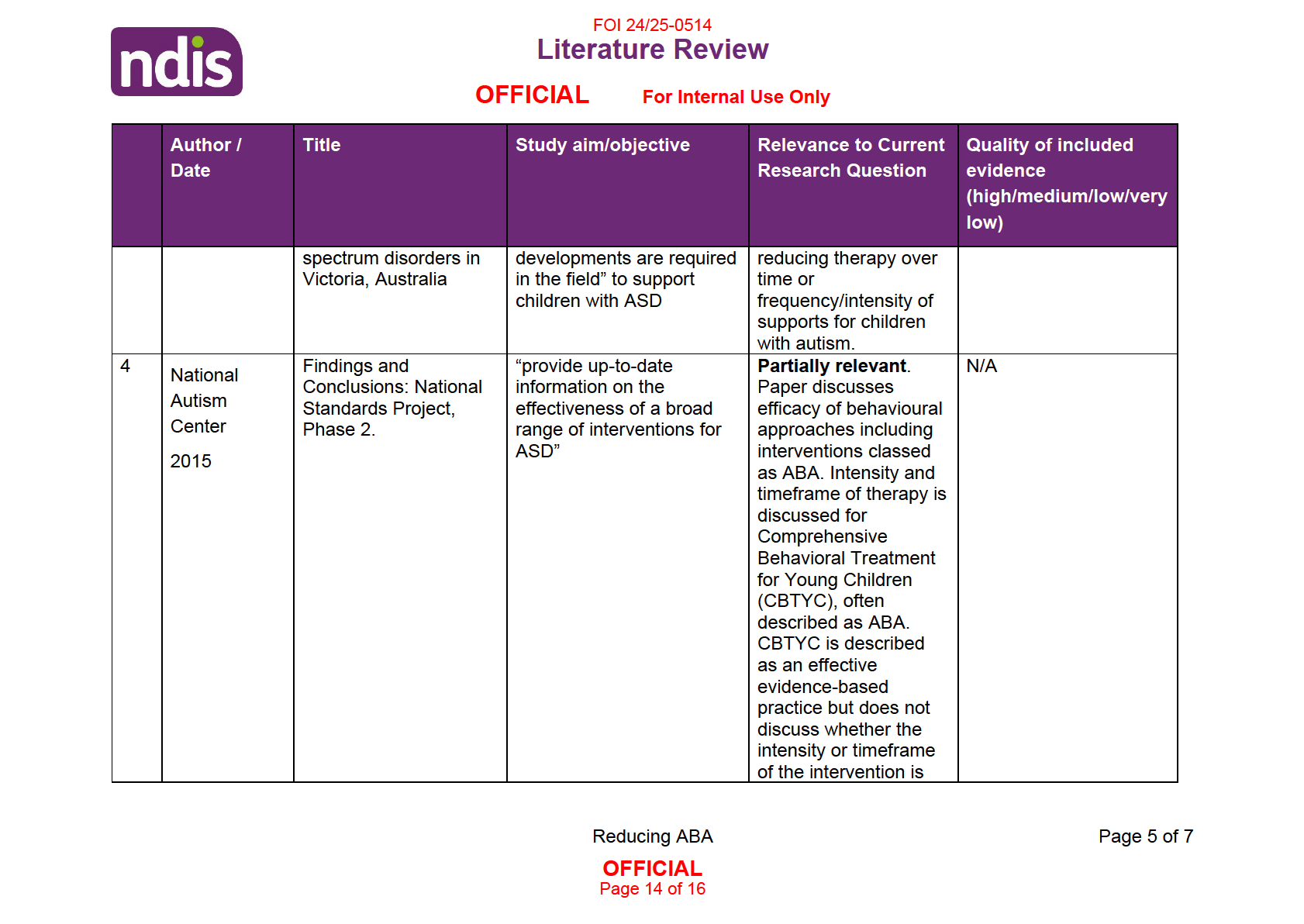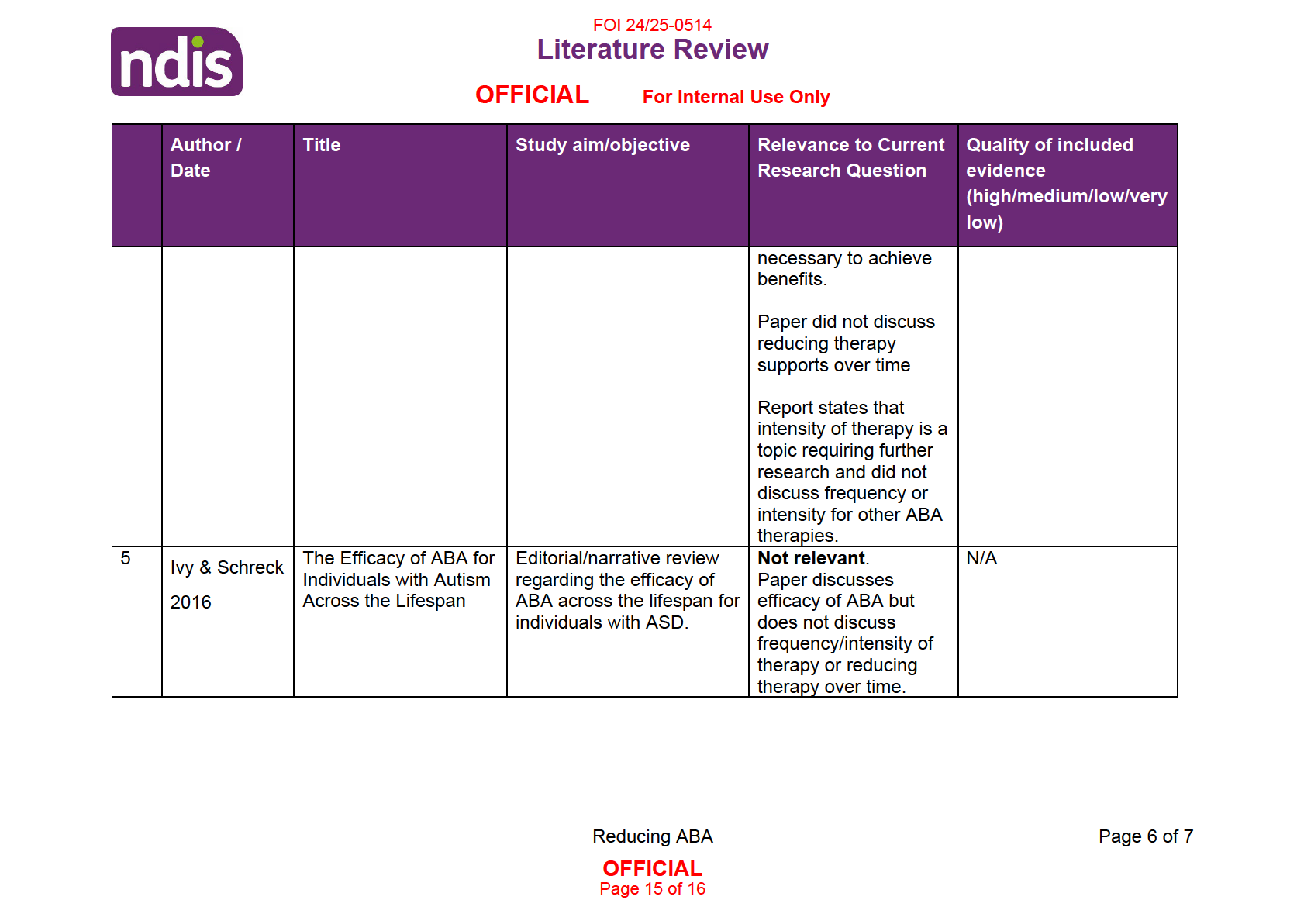
FOI 24/25-0514
DOCUMENT 2
Literature Review
OFFICIAL
For Internal Use Only
Reducing Applied Behaviour Analysis over time
The content of this document is OFFICIAL.
Please note:
The research and literature reviews collated by our TAB Research Team are not to be shared
external to the Branch. These are for internal TAB use only and are intended to assist our
advisors with their reasonable and necessary decision-making.
Delegates have access to a wide variety of comprehensive guidance material. If Delegates
require further information on access or planning matters, they are to call the TAPS line for
advice.
The Research Team are unable to ensure that the information listed below provides an
accurate & up-to-date snapshot of these matters
Research question: Is there substantial evidence that a step-down transition away from
Applied Behaviour Analysis (ABA) therapy can provide outcomes and be of benefit?
Date: 3/1/24
Requestor: Star s22(1)(a)(ii) -
Endorsed by: Naomi s22(1)(a)(ii) - irreleva
Researcher: Stephanie s22(1)(a)(ii)
,
- irrelevant mate Aaron s22(1)(a)(ii) - irrelevant ma
Cleared by: Stephanie s22(1)(a)(ii) - irrelevant mat
1. Contents
Reducing Applied Behaviour Analysis over time ........................................................................ 1
1.
Contents ....................................................................................................................... 1
2.
Summary ...................................................................................................................... 2
3.
Previous TAPIB research papers .................................................................................. 2
4.
Review of Provided Literature ....................................................................................... 2
5.
Other sources ............................................................................................................... 2
6.
Literature review table ................................................................................................... 4
7.
References ................................................................................................................... 7
Reducing ABA
Page 1 of 7
OFFICIAL
Page 10 of 16

FOI 24/25-0514
Literature Review
OFFICIAL
For Internal Use Only
2. Summary
This paper considers the evidence for a step-down model of reducing frequency or intensity of
applied behaviour analysis (ABA). No evidence was found regarding the effectiveness of a
step-down model. One international ABA accreditation body, the Behavioral Health Center of
Excellence, recommends a gradual reduction in hours when concluding ABA therapy.
Five papers were attached with the research request. None of the papers directly relate to the
efficacy of a step-down model of reducing ABA supports.
Previous TAPIB research has found a lack of consensus regarding appropriate intensity and
duration of ABA therapy. Recent Australian guidelines on the delivery of supports for children
with autism note that supports should be individualised and there is no set number of hours of
therapy which are appropriate for every child.
3. Previous TAPIB research papers
Previous TAPIB research papers related to ABA include:
• RES 246 ABA and positive behaviour support.docx
• RES 292 Applied behaviour analysis for adults with ASD.docx
RES 246 found no evidence for appropriate frequency, intensity or timeframe of ABA required
to affect a reduction in behaviours of concern, nor any information on reducing intensity of
support over time.
RES 292 found lack of consensus regarding appropriate frequency, intensity or timeframe of
ABA. The studies review in this paper emphasised that an individualised approach to
determining frequency, intensity and timeframe of supports is required.
4. Review of Provided Literature
Five papers were attached with the research request (refer to 6. Literature Review table for
further details). None of the attached papers were directly relevant to the research question.
None of the papers reviewed directly addressed the benefits of an extended timeframe of
supports or the benefits of slowly reducing ABA support over time. No quality assessment was
completed due to lack of relevance to the research question.
5. Other sources
The Behavioral Health Center of Excellence (BHCE) is a private organisation that offers
accreditation of applied behaviour analysts. They suggest fading out services gradually based
on the needs of the client (BHCE, n.d.). However, BHCE provide no evidence on which they
base this recommendation.
Reducing ABA
Page 2 of 7
OFFICIAL
Page 11 of 16

FOI 24/25-0514
Literature Review
OFFICIAL
For Internal Use Only
Autism CRC’s recent
National Guideline for supporting the learning, participation, and
wellbeing of autistic children and their families in Australia (Trembath et al, 2022), makes the
following recommendations around duration of supports:
56 . 1 The amount and duration of support provision should be tailored to the individual
needs of the child and family. This includes consideration of the frequency, length, and
time of day of support sessions, and variations in support needs over time.
56.3 Practitioners should inform parents that there is no set number of hours per week
of practitioner delivered child-directed supports that leads to the best outcomes for all
children.
56 . 4 Practitioners should be aware that research evidence does not support the
concept that supports delivered in greater amounts consistently lead to better child and
family outcomes (Trembath et al, 2022, pp.95-96).
The
National Guideline does not discuss reducing therapy over time.
Reducing ABA
Page 3 of 7
OFFICIAL
Page 12 of 16




FOI 24/25-0514
Literature Review
OFFICIAL
For Internal Use Only
7. References
Behavioral Health Center of Excellence. (n.d.).
Suggestions for Ethically Fading Out ABA
Services. https://www.bhcoe.org/2016/11/suggestions-ethically-fading-aba-services/
Camargo, S. P., Rispoli, M., Ganz, J., Hong, E. R., Davis, H., & Mason, R. (2014). A review of
the quality of behaviorally-based intervention research to improve social interaction
skills of children with ASD in inclusive settings.
Journal of autism and developmental
disorders,
44(9), 2096–2116. https://doi.org/10.1007/s10803-014-2060-7
Ivy, J.W. & Schreck, K.A. (2016). The Efficacy of ABA for Individuals with Autism Across the
Lifespan.
Current Developmental Disorder Reports, 3, 57–66.
https://doi.org/10.1007/s40474-016-0070-1
Kadar, M., McDonald, R., & Lentin, P. (2012). Evidence-based practice in occupational therapy
services for children with autism spectrum disorders in Victoria, Australia.
Australian
occupational therapy journal,
59(4), 284–293. https://doi.org/10.1111/j.1440-
1630.2012.01015.x
National Autism Center. (2015).
Findings and conclusions: National standards project, phase
2. https://www.nationalautismcenter.org/national-standards-project/phase-2/
Steinbrenner, J. R., Hume, K., Odom, S. L., Morin, K. L., Nowel , S. W., Tomaszewski, B.,
Szendrey, S., McIntyre, N. S., Yücesoy-Özkan, S., & Savage, M. N. (2020).
Evidence-
based practices for children, youth, and young adults with Autism. The University of
North Carolina at Chapel Hil , Frank Porter Graham Child Development Institute,
National Clearinghouse on Autism Evidence and Practice Review Team.
V0.0 XX-XX-XXXX
Abbreviated Title
Page 7 of 7
OFFICIAL
Page 16 of 16






